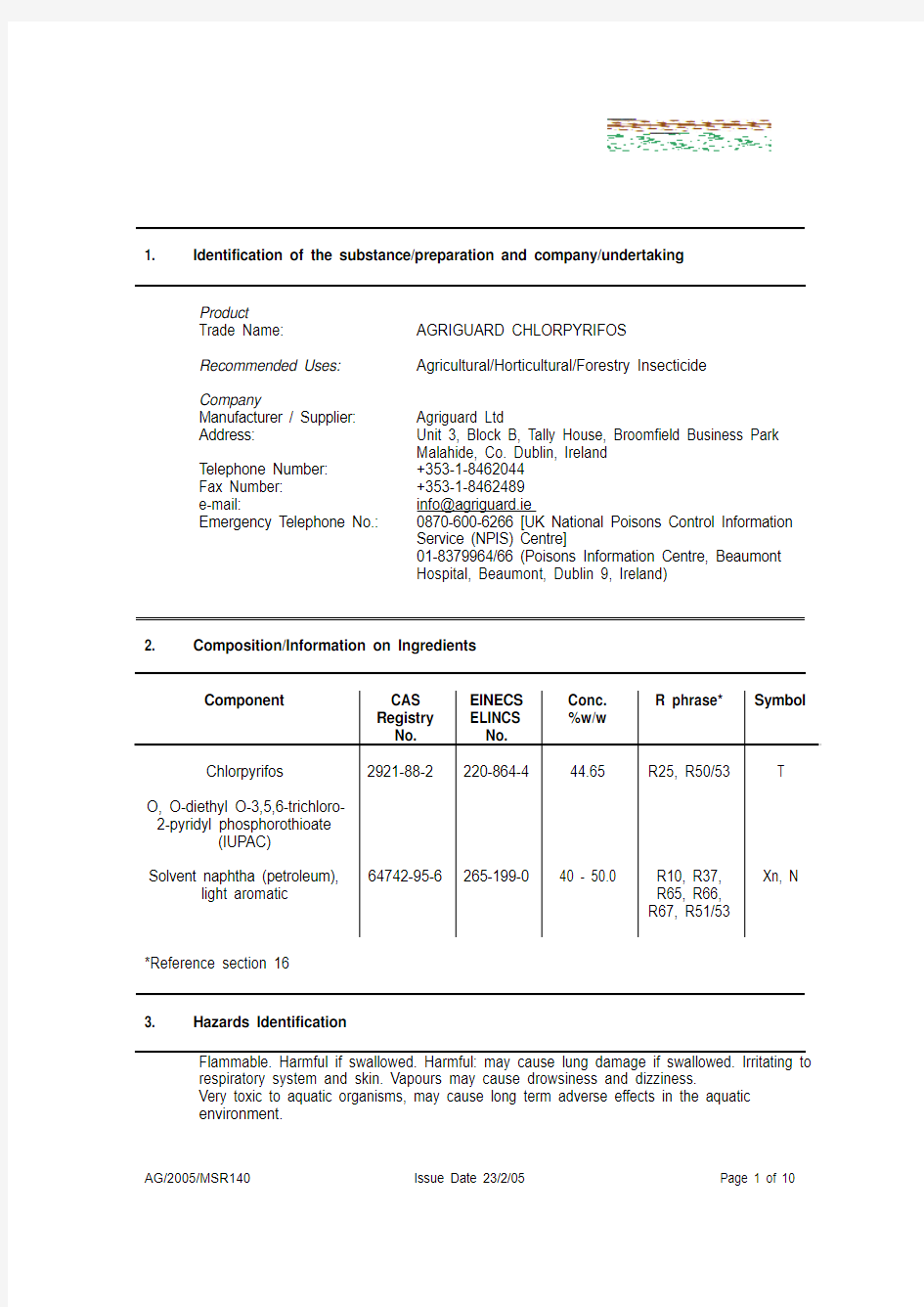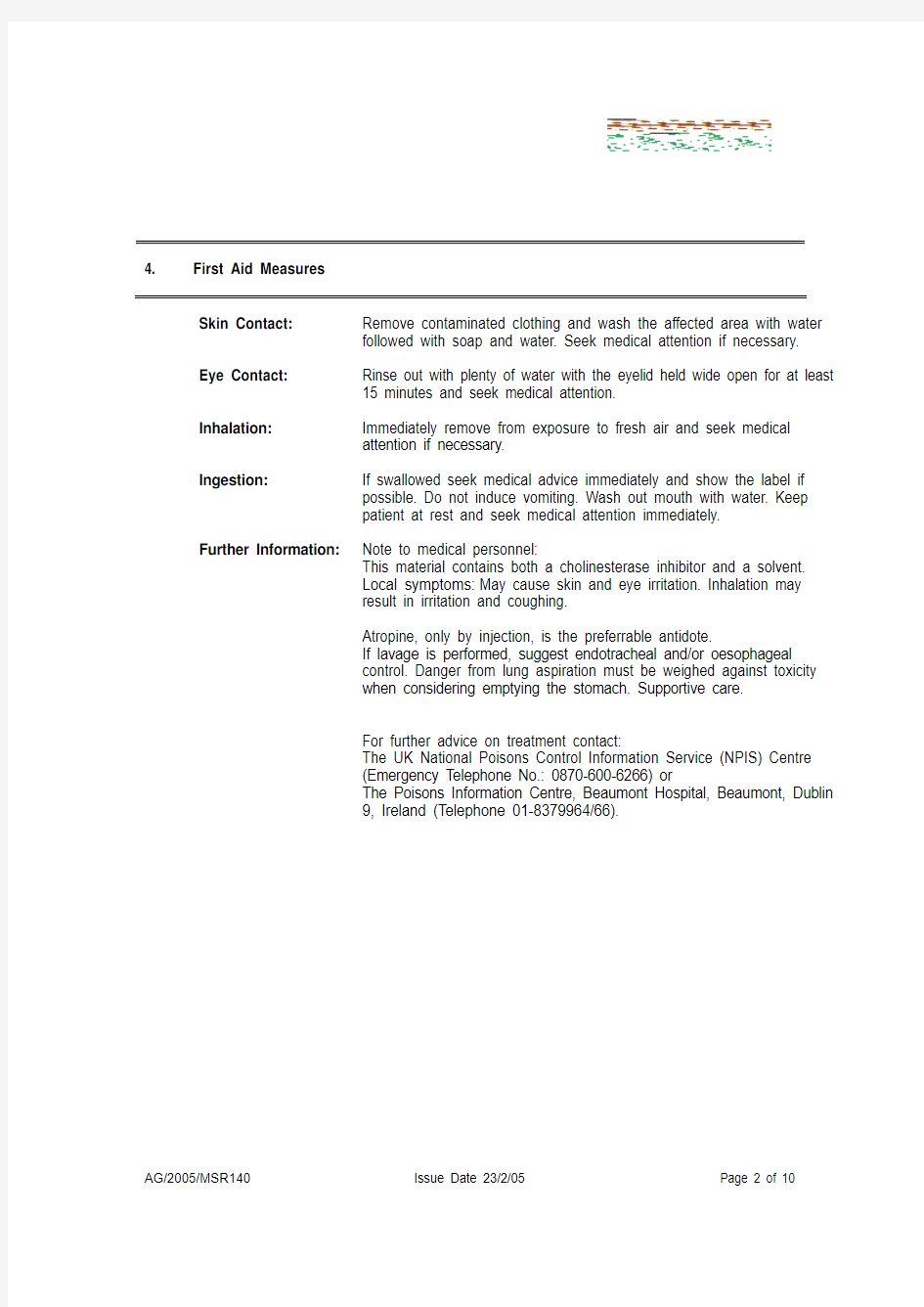

1. Identification of the substance/preparation and company/undertaking
Product
Trade Name: AGRIGUARD CHLORPYRIFOS
Recommended Uses: Agricultural/Horticultural/Forestry Insecticide
Company
Manufacturer / Supplier: Agriguard Ltd
Address: Unit 3, Block B, Tally House, Broomfield Business Park
Malahide, Co. Dublin, Ireland
Telephone Number: +353-1-8462044
Fax Number: +353-1-8462489
e-mail: info@agriguard.ie
Emergency Telephone No.: 0870-600-6266 [UK National Poisons Control Information
Service (NPIS) Centre]
01-8379964/66 (Poisons Information Centre, Beaumont
Hospital, Beaumont, Dublin 9, Ireland)
2. Composition/Information on Ingredients
Component CAS
Registry
No. EINECS
ELINCS
No.
Conc.
%w/w
R phrase* Symbol
Chlorpyrifos
O, O-diethyl O-3,5,6-trichloro-
2-pyridyl phosphorothioate
(IUPAC)
2921-88-2 220-864-4 44.65 R25, R50/53 T
Solvent naphtha (petroleum),
light aromatic 64742-95-6 265-199-0 40 - 50.0 R10, R37,
R65, R66,
R67, R51/53
Xn, N
*Reference section 16
3. Hazards Identification
Flammable. Harmful if swallowed. Harmful: may cause lung damage if swallowed. Irritating to respiratory system and skin. Vapours may cause drowsiness and dizziness.
Very toxic to aquatic organisms, may cause long term adverse effects in the aquatic
environment.
4. First Aid Measures
Skin Contact: Remove contaminated clothing and wash the affected area with water
followed with soap and water. Seek medical attention if necessary.
Eye Contact: Rinse out with plenty of water with the eyelid held wide open for at least
15 minutes and seek medical attention.
Inhalation: Immediately remove from exposure to fresh air and seek medical
attention if necessary.
Ingestion: If swallowed seek medical advice immediately and show the label if
possible. Do not induce vomiting. Wash out mouth with water. Keep
patient at rest and seek medical attention immediately.
Further Information: Note to medical personnel:
This material contains both a cholinesterase inhibitor and a solvent.
Local symptoms:May cause skin and eye irritation. Inhalation may
result in irritation and coughing.
Atropine, only by injection, is the preferrable antidote.
If lavage is performed, suggest endotracheal and/or oesophageal
control. Danger from lung aspiration must be weighed against toxicity
when considering emptying the stomach. Supportive care.
For further advice on treatment contact:
The UK National Poisons Control Information Service (NPIS) Centre
(Emergency Telephone No.: 0870-600-6266) or
The Poisons Information Centre, Beaumont Hospital, Beaumont, Dublin
9, Ireland (Telephone 01-8379964/66).
5. Fire-fighting Measures
Suitable extinguishing media: Water spray, carbon dioxide, foam or dry powder.
Extinguishing media which
must not be used for safety
reasons: High pressure water jet.
Special protective
equipment for fire-fighting: Wear self contained breathing apparatus and protective
clothing (chemical protection suit, boots and plastic or rubber
gloves). Do not breathe fumes.
Special exposure hazards:None known
Other Information: Intact containers should be removed from risk of exposure to
the fire if it is safe to do so. If it is not safe to remove them,
spray intact containers with water to keep them cool. Contain
fire-fighting water with sand or some such bunding material.
Rapid decomposition occurs above 1600C.
6. Accidental Release Measures
Personal precautionary measures:
Ensure suitable personal protection during removal of spillages. Refer to section 8 below for personal protection required.
Environmental-protection measures:
Keep the area isolated and do not allow contamination to enter the sewerage system.
If the product has entered the sewerage system or contaminated a public place advise the
appropriate authority.
Procedures for cleaning/absorption:
Contain/absorb the spillage with a suitable inert absorbent material which should then be
transferred to secure containers and sent for disposal. Wash the spillage area with water.
Washings must be prevented from entering surface water drains.
7. Handling and Storage
Handling: Keep product in original tightly closed container; do not get on skin, eyes or
clothing; do not eat drink or smoke when handling; wash hands before eating
drinking or smoking. Provide good ventilation of working area.
Storage: Store in a dry area in the original containers, access should only be for
authorised persons. Keep out of reach of children. Keep away from food, drink
and animal feeding stuffs. Protect from frost. Keep away from direct sunlight.
The product is flammable. Vapours may form explosive mixture with air. Keep
away from sources of ignition – No smoking.
8. Exposure Controls/Personal Protection
Occupational exposure limits:
Chlorpyrifos: IHG is 0.1mg/m3 (skin)
Engineering measures to reduce exposure:
Ensure adequate ventilation especially in confined areas.
Personal protective equipment:
Respiratory protection: Filter apparatus containing Filter A (short term)
Eye protection: Wear chemical resistant safety goggles conforming to BS 2092.
Hand protection: Wear chemical resistant PVC or nitrile gloves.
Avoid gloves made of natural rubber.
Skin and body protection: Wear PVC or chemical resistant disposable overalls and PVC boots.
Industrial Hygiene:
Immediately change contaminated clothing, dispose of if decontamination is not feasible.
Keep away from food, drink and animal feeding stuffs. Wash hands before breaks and
immediately after handling the product. When using, do not eat, drink or smoke.
9. Physical and Chemical Properties
Appearance: Liquid
Colour: Clear amber
Odour: Aromatic
pH: Not available
Melting Point/Melting point range: 42 – 43.5 0C (active ingredient)
Boiling Point/Boiling Point range: Not available
Flash Point: 50.5 0C
Flammability Not flammable
Autoflammability > 4500C (Naphtha solvent, petroleum)
Explosive properties:
Lower limit
Upper limit
Not explosive
Oxidising properties Not available
Vapour Pressure: 0.3 hPa @ 200C (Naphtha solvent, petroleum) Relative density: 1.078 g/ml @ 200C
Solubility
Water solubility Fat solubility Emulsifiable Not available
Partition coefficient
n-octanol/water
Log Pow 4.6 @ 250C (active ingredient) Other Data:
Viscosity Surface tension 3.59 mm2/s @ 200C 30.5 mN/m @ 250C
10. Stability and Reactivity
Stability: Stable at ambient conditions.
Conditions to avoid: Avoid extremes of pressure. Rapid decomposition
occurs above 1600C.Protect from frost.
Materials to avoid: Strong basic, acidic or oxidising materials.
Hazardous decomposition
products: None known.
11. Toxicological Information
Acute toxicity:
LD50 (oral, rat): 316 mg/kg
LD50 (skin, rat):> 2000mg/kg
Sensitisation: Does not cause sensitisation on guinea pig skin.
Further toxicological information:
After inhalation: No adverse effects to respiratory system.
After skin contact: Short single exposure may cause skin irritation
After eye contact: May cause moderate eye irritation.
Carcinogenicity: No carcinogenic potential
Mutagenicity: Not mutagenic
Reproductive toxicity: No effects on reproductive toxicity
12. Ecological Information
Ecological data is that for the active ingredient
Mobility:Immobile in soil (data is for active ingredient)
Persistence and Degradability: Does not leach in soils and is therefore unlikely
to contaminate ground water.
Half-life in soils is dependent on soil type and
conditions and is approximately 2 – 34 days.
Bioaccumulative potential: No information
Aquatic toxicity : Very toxic to fish on an acute basis (LC50 < 1 mg/L)
Very toxic to aquatic invertebrates on an acute basis
(EC50 < 1 mg/L)
Material is toxic to algae (1 mg/l < IC50 < 10mg/l) Other toxicity : Moderately toxic to birds on an acute basis
(50 mg/kg < LD50 < 500 mg/kg).
Toxic to bees.
13. Disposal Considerations
Waste from residues/unused
products:In accordance with local and national regulations. Do
not allow material to contaminate ground water system.
Do not contaminate surface water.
Contaminated packaging: Wash out container thoroughly, empty washings into
spray tank and dispose of safely.
Do not contaminate ponds, waterways or ditches with
chemical or used container. Do not re-use empty
containers.
Further information: Contact the Local Council Authority for advice on the
disposal of pesticide waste, or ask an approved waste
disposal contractor.
14. Transport Information
UN proper shipping name: Organophosphorus pesticide, liquid, toxic, flammable,
(Chlorpyrifos 48% and petroleum distillate) UN Number 3017
Road/Railway
Proper shipping name: Organophosphorus pesticide, liquid, toxic, flammable,
(Chlorpyrifos 48% and petroleum distillate) UN Number 3017
Class: 6.1
Packaging group: III
Hazard Identification No.: 63
Inland waterways
Proper shipping name: Organophosphorus pesticide, liquid, toxic, flammable,
(Chlorpyrifos 48% and petroleum distillate) UN Number: 3017
Class: 6.1
Item: 31
Letter: c
Hazard Identification No.: 63
Sea
Proper shipping name: Organophosphorus pesticide, liquid, toxic, flammable,
(Chlorpyrifos 48% and petroleum distillate) UN Number 3017
Class: 6.1
Packaging group: III
Marine pollutant: P
Air
Proper shipping name: Organophosphorus pesticide, liquid, toxic, flammable,
(Chlorpyrifos 48% and petroleum distillate) UN Number 3017
Class: 6.1
Packaging group: III
15. Regulatory Information
Classification in accordance with The Chemicals (Hazard Information and Packaging for Supply) Regulations 2002: CHIP 3.
Hazardous components which must be listed on the label:
Deltamethrin
Solvent naphtha (petroleum), light aromatic
Symbol(s): Xn Harmful
N Dangerous for the environment
R phrases: R10 Flammable
R22 Harmful if swallowed
R37/38 Irritating to respiratory system and skin
R41 Risk of serious damage to eyes
R50/53 Very toxic to aquatic organisms, may cause long-term adverse
effects in the aquatic environment
R65 Harmful: may cause lung damage if swallowed
R67 Vapours may cause drowsiness and dizziness.
S phrases: S2 Keep out of reach of children
S25 Avoid contact with eyes.
S35 This material and its container must be disposed of in a
safe way
S37 Wear suitable gloves
S57 Use appropriate containment to avoid environmental
contamination
S62 If swallowed, do not induce vomiting: seek medical advice
immediately and show this container or label.
Designated name: AGRIGUARD CHLORPYRIFOS (contains Chlorpyrifos 480g/l)
This product is covered by the Control of Pesticides Regulations, 1986, and is labelled
accordingly (MAPP 10626).
16. Other Information
Health and Environmental Hazards
Text of R phrases mentioned in Section 2
R phrases: R10 Flammable
R25 Toxic if swallowed
R37 Irritating to respiratory system
R50/53 Very toxic to aquatic organisms, may cause long-term adverse
effects in the aquatic environment
R51/53 Toxic to aquatic organisms, may cause long-term adverse
effects in the aquatic environment
R52/53 Harmful to aquatic organisms, may cause long-term adverse
effects in the aquatic environment
R65 Harmful: may cause lung damage if swallowed
R66 Repeated exposure may cause skin dryness or cracking
R67 Vapours may cause drowsiness and dizziness Recommended Uses: Agricultural/Horticultural/Forestry Insecticide
Recommended Restrictions: Refer to statutory conditions on approved product label
Further information:
Date of First Issue: 23rd February 2005
Disclaimer: The information contained in this MSDS is designed to give general health and safety guidance on the storage and transport of the substance/preparation to which it relates.
Requirements arising from a Risk Assessment of the substance/preparation in a
particular working environment should take precedence over any of the guidance
contained in this MSDS where there is a difference in the information given. The
information contained in this MSDS is accurate at the date of publication and will be
updated as and when appropriate. Liability will not be accepted for any injury, loss or
damage resulting from any failure to take account of information or advice contained in
this MSDS.
Compiled in accordance with EC Directive 91/155/EEC and subsequent amendments
EC Directives 93/112/EEC and 2001/58/EC.